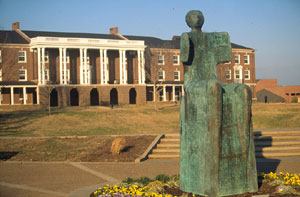
Austin Peay State University
Located in Clarksville, Austin Peay State University was founded on April 26, 1927, and named for Governor Austin Peay, a Clarksville resident.
The campus had been the location of educational institutions dating back to 1806. The first on the site was an academy that operated until 1848, when the Masonic Order established a college that continued until Stewart College was created in 1855. In 1875 the Presbyterian Church opened Southwestern Presbyterian College in Clarksville, where it remained until 1925. The Presbyterian Synod then moved the college to Memphis to be nearer its student population base in West Tennessee.
The loss of Southwestern represented a severe blow for the upper Middle Tennessee area, and efforts began immediately to replace it. With support from Peay and state commissioner of education Perry L. Harned, Montgomery Countians pushed to acquire a state normal school for the vacated Southwestern facilities on College Street.
On August 4, 1927, Southwestern Presbyterian deeded the thirty-acre campus to the state. After a hard political fight, the general assembly produced a bill that proposed the establishment of “a Normal School in Clarksville for the purpose of training white teachers for the rural public schools of the state.” When Austin Peay died suddenly on October 2, 1927, it seemed appropriate to place his name on the newly established Normal School.
Austin Peay Normal School officially opened September 23, 1929 in a ceremony attended by Governor Henry Horton and World War I hero Alvin C. York. The new normal school offered a two-year curriculum designed to prepare graduates to pass the state certification requirements for teachers in elementary schools or receive a junior college diploma. Compared to contemporary standards, the curriculum required few course hours but upheld rigorous course requirements.
Harned, a vigorous advocate of teacher preparation and certification, selected Dr. Philander P. Claxton to serve as the school’s second president after the sudden death of President John S. Ziegler. Claxton, a former U.S. commissioner of education under Woodrow Wilson and organizer of the University of Tennessee Summer School of the South, joined Harned in promoting the need to rehabilitate rural life through education. When Harned’s tenure as education commissioner ended in 1933, Claxton continued his efforts to foster rural education. On February 25, 1939, Austin Peay Normal was elevated to the status of a three-year institution, with provisions to add a fourth year in 1941. The school received the designation of a college in February 1943.
President Claxton retired in 1946 and was succeeded by former Austin Peay history professor, administrator, and former state commissioner of education Halbert Harvill. In Harvill’s first year of service, the Southern Association of Colleges and Secondary Schools accepted Austin Peay College for membership, thereby conferring national accreditation on its programs.
Between 1946 and 1962, Harvill led a major building program that included the expansion and modernization of the school’s academic buildings, residence halls, and administration building. The college became a member of the American Association of Colleges for Teacher Education in 1951, a boost for the former normal school’s teacher preparation program.
Within the campus community a number of significant changes occurred as Austin Peay College adjusted to contemporary events. Typical of the relatively peaceful integration of the state’s school system, the first African American, the Reverend Wilbur Daniel, gained admission to Austin Peay in January 1956. He enrolled in the graduate school and received his M.A. degree in 1957. By 1958 black students entered the undergraduate population and at present compose approximately 16 percent of the enrollment. A benchmark for Austin Peay occurred in November 1966, when the State Board of Education approved the school for university status. This move, effective September 1, 1967, promoted more serious campus conversation concerning the traditional mission of an university–instruction, research, and community service. The long-simmering debate over the direction of the institution dating back to the 1920s which pitted teacher training against emphasis on the liberal arts and sciences was renewed with greater intensity.
In terms of faculty size, the three colleges of the university during the 1970s continually moved toward a predominantly liberal arts and sciences college, with the college of business and that of education receding to second and third place, respectively. Austin Peay provided courses at nearby Fort Campbell, Kentucky, where its role evolved from the establishment of “Eagle University” in 1972 to the present-day Fort Campbell Center, which offers both associate degrees and a bachelor’s degree.
Austin Peay State University completely departed from its original mission as a “teacher college for rural white schools” when, on December 14, 1984, the State Board of Regents recommended that it be designated as a liberal arts institution. A transitional period in terms of funding requirements followed the designation as the university adjusted admissions standards to secure more academically capable students.
By 1996 Austin Peay State University had become a regional institution with its chief mission being liberal arts and science. Enrollment in the fall of 1999 totaled 7,440 students; the campus included two hundred acres. Today the university offers forty undergraduate majors in five academic colleges. The dreams of Perry Harned and Philander P. Claxton has borne fruit, and Austin Peay State University prepares to enter the twenty-first century “known for thoroughness in subject matter and for teaching independent thought to its students.” (1)



